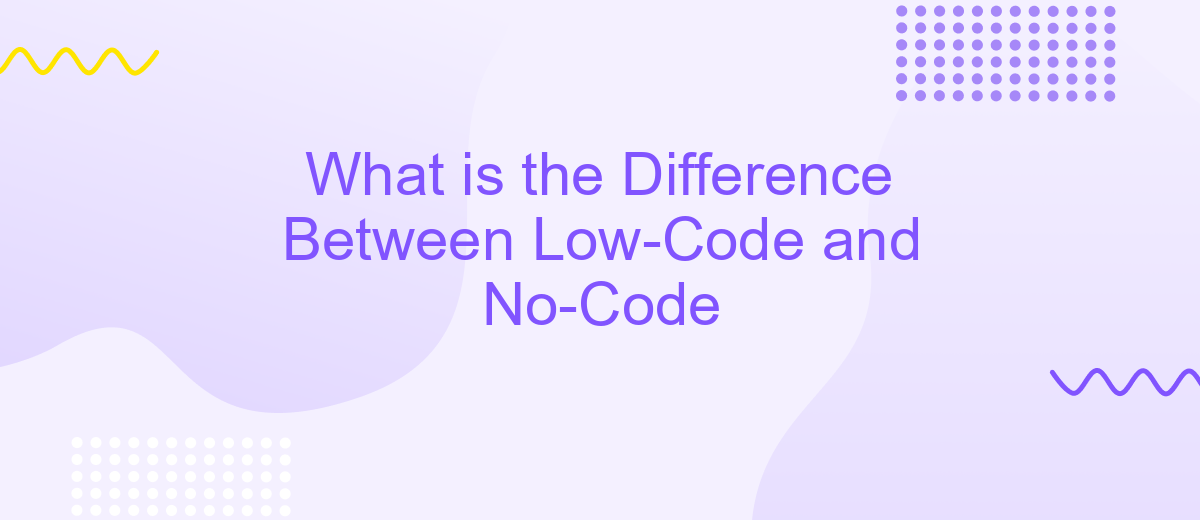What is the Difference Between Low-Code and No-Code
In today's fast-paced digital world, businesses are increasingly turning to low-code and no-code platforms to accelerate software development and innovation. While both approaches aim to simplify the creation of applications, they cater to different levels of technical expertise and project complexity. This article explores the key differences between low-code and no-code platforms, helping you choose the right solution for your needs.
Introduction
In today's rapidly evolving technological landscape, businesses are constantly seeking ways to streamline their development processes and reduce the time it takes to bring applications to market. This has led to the rise of low-code and no-code platforms, which empower users to create applications with minimal or no coding skills. These platforms have become game-changers, enabling organizations to innovate faster and more efficiently.
- Low-code platforms: Require some coding knowledge and are ideal for professional developers who want to expedite the development process.
- No-code platforms: Designed for non-technical users, allowing them to build applications without writing any code.
By leveraging tools like ApiX-Drive, businesses can further enhance their development workflows. ApiX-Drive simplifies the integration of various services and applications, making it easier for both low-code and no-code platforms to communicate and share data seamlessly. Understanding the differences between low-code and no-code platforms is crucial for selecting the right approach to meet your organization's unique needs.
Understanding Low-Code

Low-code development platforms empower users to create applications with minimal hand-coding, leveraging visual interfaces and pre-built templates. These platforms are designed to accelerate the development process, making it accessible to those with limited coding expertise. By using drag-and-drop functionality, users can design workflows, set up integrations, and deploy applications swiftly. This approach significantly reduces the time and cost associated with traditional software development.
One of the key advantages of low-code platforms is their ability to integrate with various services and APIs seamlessly. For instance, ApiX-Drive allows users to connect different applications and automate workflows without extensive coding knowledge. This integration capability ensures that businesses can streamline their operations and enhance productivity. By utilizing low-code platforms, organizations can quickly adapt to changing market demands and innovate more efficiently.
Diving into No-Code

No-code platforms are designed to empower users without any programming knowledge to create applications and automate workflows. These platforms use visual development environments where users can drag and drop elements to build their projects. This approach democratizes software development, making it accessible to a broader audience.
- Visual Development: Users can create applications using intuitive interfaces without writing a single line of code.
- Pre-built Templates: Many no-code platforms offer a variety of templates to help users get started quickly.
- Integration Capabilities: Tools like ApiX-Drive enable users to connect different applications and automate data transfer between them effortlessly.
By leveraging no-code platforms, businesses can significantly reduce development time and costs. These tools are particularly beneficial for small and medium-sized enterprises that may not have extensive IT resources. With services like ApiX-Drive, users can seamlessly integrate various applications, enhancing productivity and operational efficiency. No-code platforms are transforming the way we approach software development, making it more inclusive and efficient.
Comparative Analysis of Low-Code and No-Code

Low-code and no-code platforms have become essential tools for modern businesses, enabling rapid application development with minimal coding. While both aim to simplify the development process, they cater to different user needs and technical requirements.
Low-code platforms are designed for developers who have some coding knowledge but want to accelerate their workflow. These platforms offer pre-built modules and drag-and-drop interfaces, allowing for customization through code when needed. On the other hand, no-code platforms are tailored for non-technical users, providing a fully visual development environment where applications can be built entirely through graphical interfaces without any coding.
- Low-code: Requires some coding knowledge, offers more flexibility.
- No-code: No coding required, ideal for non-technical users.
- Low-code: Suitable for complex applications.
- No-code: Best for simple to moderately complex applications.
When it comes to integrating various services, both low-code and no-code platforms can benefit from tools like ApiX-Drive. ApiX-Drive allows for seamless integration between different applications, streamlining workflows without the need for extensive coding. This makes it easier for businesses to connect their software ecosystems, regardless of whether they are using low-code or no-code solutions.
- Automate the work of an online store or landing
- Empower through integration
- Don't spend money on programmers and integrators
- Save time by automating routine tasks
Conclusion
In conclusion, both low-code and no-code platforms offer significant advantages for businesses looking to accelerate their development processes. Low-code platforms provide a middle ground, enabling developers with some coding knowledge to create complex applications more efficiently. On the other hand, no-code platforms empower non-technical users to build functional applications without any coding skills, democratizing the development process and fostering innovation across various departments.
As companies strive to streamline their operations and integrate various services, tools like ApiX-Drive become crucial. ApiX-Drive facilitates seamless integration between different applications, allowing businesses to automate workflows and enhance productivity. Whether leveraging low-code or no-code solutions, incorporating a robust integration tool like ApiX-Drive ensures that your applications can communicate effectively, providing a cohesive and efficient digital ecosystem. Ultimately, the choice between low-code and no-code depends on your specific needs, resources, and the complexity of the applications you aim to develop.
FAQ
What is the main difference between low-code and no-code platforms?
Who typically uses low-code platforms?
Can no-code platforms handle complex integrations?
Is it possible to scale applications built with no-code platforms?
Are low-code and no-code platforms secure?
Routine tasks take a lot of time from employees? Do they burn out, do not have enough working day for the main duties and important things? Do you understand that the only way out of this situation in modern realities is automation? Try Apix-Drive for free and make sure that the online connector in 5 minutes of setting up integration will remove a significant part of the routine from your life and free up time for you and your employees.


